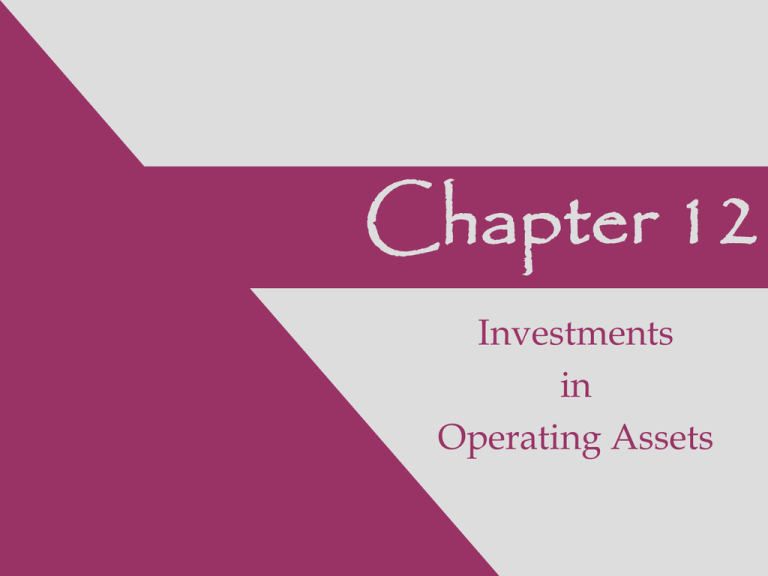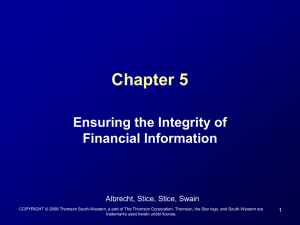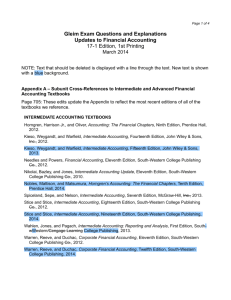CHAPTER 11
advertisement

Chapter 12 Investments in Operating Assets Financial Statement Items Covered Balance Sheet Long-term Assets Property, Plant, & Equipment Accumulated Depreciation Intangible Assets Income Statement Depreciation Expense Amortization Expense Loss on Impairment Financial Accounting, 7e Stice/Stice, 2006 © Thomson Statement of Cash Flows Operating Asset depreciation (indirect method) Financing Cash paid (received) to purchase (from sale of) long-term assets Cash paid to acquire another company 2 What are Long-Term Operating Assets? Long-Term Operating Assets Long-term operating assets are – not held for resale to customers – are used by a business to generate revenues Long-term operating assets include – Property, plant, and equipment – Intangible assets Financial Accounting, 7e Stice/Stice, 2006 © Thomson 4 Property, Plant, and Equipment “PP&E” – Tangible, long-lived assets – Acquired for use in business operations •Land •Buildings •Machinery •Equipment •Furniture Financial Accounting, 7e Stice/Stice, 2006 © Thomson 5 Intangible Assets Long-lived assets – Used to facilitate the operation of a business – Do not have physical substance •Patents •Trademarks •Licenses •Franchises •Goodwill Financial Accounting, 7e Stice/Stice, 2006 © Thomson 6 Long-Term Asset Issues Evaluate Acquire Estimate and Recognize possible acquisition of long-term operating assets long-term operating assets periodic depreciation Financial Accounting, 7e Stice/Stice, 2006 © Thomson Monitor Dispose asset value for possible decline of the asset 7 Deciding Whether to Acquire a Long-Term Operating Asset Capital Budgeting The process of evaluating a long-term project that may include purchasing property, plant, and equipment Common capital budgeting models: – Payback period – Accounting rate of return – Net present value Financial Accounting, 7e Stice/Stice, 2006 © Thomson 9 Payback Period The time it takes for a company to recover its original investment in cash Initial Investment Payback Period = Annual Cash Inflow Financial Accounting, 7e Stice/Stice, 2006 © Thomson 10 Accounting Rate of Return Projects are approved if their rate of return exceeds some predetermined rate Accounting Rate = Annual Accounting Income of Return Initial Investment Financial Accounting, 7e Stice/Stice, 2006 © Thomson 11 Net Present Value Utilizes the concept of the time value of money A project is undertaken only if the present value of the cash inflows from the project exceeds the present value of the cash outflow Financial Accounting, 7e Stice/Stice, 2006 © Thomson 12 Acquisition of Plant, Property, & Equipment Acquisition of PP&E The cost of PP&E includes any costs necessary to bring the asset to the condition and location for its intended use Financial Accounting, 7e Stice/Stice, 2006 © Thomson 14 Items Included in PP&E Acquisition Cost Land Purchase price, commissions, legal fees, escrow fees, surveying fees, clearing and grading costs Land Improvements (e.g., landscaping, paving, fencing) Cost of improvements, including expenditures for materials, labor and overhead Buildings Purchase price, commissions, reconditioning costs Equipment Purchase price, taxes, freight, insurance, installation, and any expenditures incurred in preparing the asset for its intended use Financial Accounting, 7e Stice/Stice, 2006 © Thomson 15 Acquisition for Cash Purchase price Discount* Net Price 6% sales tax on purchase price Freight charges Installation costs Total Acquisition Cost $900 850 150 $15,000 (300) $14,700 1,900 $16,600 *terms 2/10, n/30; payment made within discount period Financial Accounting, 7e Stice/Stice, 2006 © Thomson 16 Subsequent Expenditures Normal repairs and maintenance are expensed in the current period Expenditures which extend the useful life or increase the productive capacity are capitalized – Asset book value is increased – Annual depreciation is revised Financial Accounting, 7e Stice/Stice, 2006 © Thomson 17 Acquisition Through Leasing A lease is a contract whereby • one party (lessee) • is granted the right to use property • owned by another party (lessor) • for a specified period of time for a specified cost Financial Accounting, 7e Stice/Stice, 2006 © Thomson 18 Lease Types Operating lease - equivalent to a rental – Lease payments charged to expense Capital lease – equivalent to a purchase – The asset acquired is recorded in property, plant and equipment The leased asset is depreciated over the lease period – A lease liability is shown in the liability section of the balance sheet Financial Accounting, 7e Stice/Stice, 2006 © Thomson 19 Acquisition by Exchange The acquisition price of the asset is equal to fair market value of noncash consideration plus any cash given Land Capital Stock 780,000 780,000 To record the purchase of land in exchange for 10,000 shares of stock when market price of the stock was $78 per share Financial Accounting, 7e Stice/Stice, 2006 © Thomson 20 Acquisition Through Donation The asset is recorded at its fair market value at time it is received Land Gain - Donated Asset 500,000 500,000 To record the receipt of land through donation. Financial Accounting, 7e Stice/Stice, 2006 © Thomson 21 Acquisition With a Basket Purchase Fixed assets purchased for a lump sum need to be recorded separately The total purchase price must be allocated among individual assets received in proportion to their appraised values Financial Accounting, 7e Stice/Stice, 2006 © Thomson 22 Example: Acquisition With a Basket Purchase Fair Value of Assets: Land 300,000 Building 900,000 Price Paid $1,000,000 Land Building Appraised Relative Value Percentage Allocation 300,000 25.0% 250,000 900,000 75.0% 750,000 1,200,000 Financial Accounting, 7e Stice/Stice, 2006 © Thomson 100.0% 1,000,000 23 Acquisition of an Entire Company All acquired assets are recorded on the books of the acquiring company at their fair values as of the acquisition date The excess of the purchase price over the fair value of the identifiable assets represents goodwill Financial Accounting, 7e Stice/Stice, 2006 © Thomson 24 Acquisition Through Self-Construction Self-constructed assets are recorded at cost, including all expenditures necessary to build the asset and make it ready for its intended use Financial Accounting, 7e Stice/Stice, 2006 © Thomson 25 Acquisition Through Self-Construction Costs include: – Materials and labor used directly in construction – A reasonable share of general overhead – If interest is included it is called capitalized interest Interest should be included equal to the amount that could have been saved if the money used on the construction had instead been used to repay loans Financial Accounting, 7e Stice/Stice, 2006 © Thomson 26 Acquisition of Intangible Assets Intangible Assets • Long-term • Nonmonetary • Generate revenues – Grant a right to use of a product, process, name, image, customer list, or business practice • Uncertainty about future benefits greater than that of tangible assets • Specifically identifiable – Except goodwill Financial Accounting, 7e Stice/Stice, 2006 © Thomson 28 Patent An exclusive right to use, manufacture, process, or sell a product granted by the U.S. Patent Office. Patents have a legal life of 17 years, but their economic life may be shorter Copyright The exclusive right of the creator or heirs to reproduce and/or sell an artistic or published work. Granted by the U.S. government for a period of 50 years after the death of the creator. Amortized over the shorter of its economic life or legal life. Trademark and Trade Names A symbol or name that allows the holder to use it to identify or name a specific product or service. A legal registration system allows for an indefinite number of 20-year renewals Franchise An exclusive right to use a formula, design, technique, or territory. Goodwill The ability of a company to earn above-normal income. Recorded goodwill is the excess amount paid to acquire a company, over and above the fair market value of the company’s identifiable assets. Accounting for Goodwill A business combination occurs when one company buys all of the assets of another company The combination is accounted for using the purchase method (as if one company is buying the other) Financial Accounting, 7e Stice/Stice, 2006 © Thomson 34 Purchase Method The identifiable assets and liabilities are recorded at their fair values – The excess of the purchase price over the fair value of the identifiable net assets is recorded as goodwill • Goodwill represents the company’s reputation, superior business practices, and market position • Goodwill is only recorded when it is purchased Financial Accounting, 7e Stice/Stice, 2006 © Thomson 35 Determining Goodwill Book Value Fair Value Difference Assets: Cash Accounts Receivable Inventory Plant, Property, & Equip Patent Liabilities Accounts Payable Long-term debt 50,000 250,000 400,000 350,000 - 50,000 250,000 450,000 500,000 100,000 (100,000) (200,000) (100,000) (200,000) Net Assets 750,000 1,050,000 50,000 150,000 100,000 - Purchase price paid Net assets, book value 1,300,000 (750,000) 550,000 Adjust net assets to fair value: Inventory Plant, Property, & Equip Patent Goodwill Financial Accounting, 7e Stice/Stice, 2006 © Thomson 50,000 150,000 100,000 300,000 250,000 36 Depreciation and Amortization Depreciation: What it Is ... and Isn’t IS • The systematic allocation of an asset’s cost to the periods of benefit Financial Accounting, 7e Stice/Stice, 2006 © Thomson IS NOT • Accumulation of a cash fund for asset replacement • A determination of an asset’s current value 38 Depreciation Causes of depreciation: – Physical deterioration •Due to use, passage of time, and exposure to the elements – Obsolescence •Outdated, outmoded, or inadequate Financial Accounting, 7e Stice/Stice, 2006 © Thomson 39 Depreciation Factors Residual value (salvage value) – An estimate of the asset’s worth at the time of its disposal Depreciable cost – The original cost minus the residual value Estimated useful life – A measure of the service potential in terms of years or units produced Financial Accounting, 7e Stice/Stice, 2006 © Thomson 40 Depreciation Methods Straight-line – Allocates an equal amount of asset cost per year Units-of-production – Allocates cost based on the productive output of the asset Declining balance – An accelerated method which allocates more cost to depreciation in the early years than the later years Financial Accounting, 7e Stice/Stice, 2006 © Thomson 41 Depreciation Methods Illustrated Assume the following information: Equipment purchase date January 1, 2006 Acquisition cost $40,000 Estimated residual value $4,000 Depreciable cost $36,000 Estimated useful life 5 years Financial Accounting, 7e Stice/Stice, 2006 © Thomson 42 Straight-Line Depreciation Cost - Residual Value Useful Life $40,000 - $4,000 5 years = Annual Depreciation = $7,200 Year Depreciation Accum Dep Book Value 2006 2007 2008 2009 2010 7,200 7,200 7,200 7,200 7,200 7,200 14,400 21,600 28,800 36,000 Financial Accounting, 7e Stice/Stice, 2006 © Thomson 32,800 25,600 18,400 11,200 4,000 43 Straight-Line Method Straight-line Depreciation $35,000 $30,000 $25,000 $20,000 $15,000 $10,000 $5,000 $0 1 2 3 4 5 An equal amount of depreciation expense is allocated to each period Year Annual Depreciation End of Year Book Value Financial Accounting, 7e Stice/Stice, 2006 © Thomson 44 Declining-Balance Method Annual depreciation is determined by applying a fixed percentage to the remaining book value at the beginning of each year 1 rate = percentage rate life 1 2 = 40% 5 ‘rate’ is the multiple of straight-line (double is 2 times the straight-line rate) Financial Accounting, 7e Stice/Stice, 2006 © Thomson 45 Declining-Balance Method 40% remaining book value 40% (cost - accum dep) Year 1: 40% ($40,000 - 0) = $16,000 Year 2: 40% ($40,000 - $16,000) = $9,600 Year 2006 2007 2008 2009 2010 Beginning Book Value Depreciation Accum Dep 40,000 16,000 16,000 24,000 9,600 25,600 14,400 5,760 31,360 8,640 3,456 34,816 5,184 1,184 36,000 Financial Accounting, 7e Stice/Stice, 2006 © Thomson Ending Book Value 24,000 14,400 8,640 5,184 4,000 2010’s expense is adjusted so that ending book value is not less than established residual value 46 Declining-Balance Method Double Declining-Balance Depreciation $30,000 $25,000 $20,000 $15,000 $10,000 $5,000 $0 1 2 3 4 5 Year Annual Depreciation Accelerated methods allocate a greater portion of cost to the earlier years of the asset’s life End of Year Book Value Financial Accounting, 7e Stice/Stice, 2006 © Thomson 47 Comparison of Straight-line and Double-Declining Balance $18,000 $16,000 $14,000 Both methods allocate a depreciable cost of $36,000 over a fiveyear period $12,000 $10,000 $8,000 $6,000 $4,000 $2,000 $0 1 2 Straight-Line Method 3 4 5 Year Declining Balance Method Financial Accounting, 7e Stice/Stice, 2006 © Thomson 48 Selecting a Depreciation Method for Financial Reporting Purposes Management may choose any GAAP-based method for financial reporting Theoretically, best to use a method that reflects the pattern of the asset’s revenues or benefits – The straight-line method is appropriate for assets whose benefits diminish on a fairly uniform basis – The double-declining-balance method is appropriate for assets that give up a greater portion of their benefits in the early years Most companies use the straight-line method due to its simplicity Financial Accounting, 7e Stice/Stice, 2006 © Thomson 49 Choosing a Depreciation Method for Tax Purposes IRS Code stipulates depreciation method and techniques – Method depends on the statutory “class life” category – Current recovery periods range from 3 to 20 years for personal property Financial Accounting, 7e Stice/Stice, 2006 © Thomson 50 IRS Depreciation Recovery Periods and Lives Cost Recovery Period (Yrs) Personal Property 4 years or less 4 to < 10 years 10 to < 16 years 16 to < 20 years 20 to < 25 years 25 years or more Real Property residential rental nonresidential 3 5 7 10 15 20 27.5 39 Method 200% DB 150% DB straight-line Choosing a Depreciation Method for Tax Purposes Salvage value is ignored for tax purposes The half-year convention is used – Property is depreciated for half the taxable year in which it is placed in service, regardless of when use actually begins Deferred tax liability arises – Accelerated depreciation for tax purpose vs straight-line depreciation for financial purpose – Earlier years have higher tax deductions – Later years have higher taxable income Financial Accounting, 7e Stice/Stice, 2006 © Thomson 52 Depreciation and Cash Flow Depreciation is not a source of cash; it is a noncash expense Depreciation indirectly affects cash flow – depreciation reduces taxable income – results in lower income taxes being paid Financial Accounting, 7e Stice/Stice, 2006 © Thomson 53 Changes in Estimated Useful Lives Later events may require changes in estimates of economic life and residual value – A change in estimate is not an error correction – A change in estimate is reflected by spreading the remaining depreciable cost over the remaining useful life of the asset Financial Accounting, 7e Stice/Stice, 2006 © Thomson 54 Amortization of Intangible Assets Finite life intangibles: – Amortize over the economic useful life or legal life, whichever is shorter – Not to exceed 40 years – Direct subtraction from the asset account Indefinite life intangibles: – No amortization Financial Accounting, 7e Stice/Stice, 2006 © Thomson 55 Impairment of Asset Value Impairment of Asset Value Occurs when an event happens after the purchase of an asset that reduces its value – Recognized in the financial statements as a reduction in the value of the asset on the balance sheet and a loss on the income statement Financial Accounting, 7e Stice/Stice, 2006 © Thomson 57 Recording Decreases in the Value of PP&E A two-step process to identify impairments and record decreases in the value of PP&E Identify: An impairment loss exists if the sum of estimated future cash flows from the asset is less than its book value Record: An impairment is measured as the difference between the book value of the asset and the fair value Financial Accounting, 7e Stice/Stice, 2006 © Thomson 58 Impairment of Intangible Assets Intangibles must be evaluated to determine if – Their estimated useful life has changed – The intangible has become impaired Financial Accounting, 7e Stice/Stice, 2006 © Thomson 59 Recording Increases in the Value of PP&E U.S. GAAP – The principle of conservatism controls – Increases in the value of PP&E are not allowed under current U.S. GAAP – Gains are recognized in income only when assets are sold IAS GAAP – Upward revaluation permitted Financial Accounting, 7e Stice/Stice, 2006 © Thomson 60 Disposal of Long-Term Assets Disposal of Long-Term Assets Disposal of long-term assets can occur through retirement, sale, or trade-in of operating assets In each case, depreciation must be recorded up to the date of the disposal and any gain or loss recognized Financial Accounting, 7e Stice/Stice, 2006 © Thomson 62 Retirement Occurs when an operating asset is removed from service and is disposed of without the company receiving any proceeds An difference between the cost and balance in the accumulated depreciation account results in a loss on retirement Financial Accounting, 7e Stice/Stice, 2006 © Thomson 63 Sale A gain occurs if the cash or other assets received are greater than the book value at the time of sale A loss occurs if the consideration received is less than the book value at the time of sale Gains/Losses are reported in “Other” section of the Income Statement Financial Accounting, 7e Stice/Stice, 2006 © Thomson 64 Sale: Two Examples Case 1 Cash received Book Value of Truck Cost Accum Dep Case 2 7,000 35,000 30,000 Gain (Loss) on Sale 5,000 4,000 35,000 30,000 2,000 5,000 (1,000) When the disposal is recorded in the accounting records, both the original cost of the truck and the accumulated depreciation on the truck are removed from the books. Financial Accounting, 7e Stice/Stice, 2006 © Thomson 65 Trade-In Trade-in allowance > book value of the asset given up a gain is realized Trade-in allowance < book value of the asset given up a loss is realized Financial Accounting, 7e Stice/Stice, 2006 © Thomson 66 Measuring PP&E Efficiency Fixed Asset (PPE)Turnover Used to evaluate the appropriateness of the level of a company’s PP&E Sales Fixed Asset Turnover = Average PP&E Can be interpreted as the number of dollars in sales generated by each dollar of fixed assets Financial Accounting, 7e Stice/Stice, 2006 © Thomson 68 Fixed Asset Turnover Dangers The ratios for two companies in different industries cannot be compared The reported amount of PP&E can be a poor indicator of fair value Sales generated by leased assets are included in the numerator, but the leased assets are not included in the denominator; upward bias in the ratio Financial Accounting, 7e Stice/Stice, 2006 © Thomson 69 In Summary ... • Long-term assets provide the infrastructure for production and distribution • Capital budgeting models include the payback period, accounting rate of return, and net present value analysis • Patents, franchises, licenses, and goodwill are intangible assets. • Straight-line and declining balance are common depreciation methods • Recognizing impairment for PPE is a two-step process • Gain (loss) on asset disposal occurs if proceeds received are greater (less) than the asset’s book value at date of sale Financial Accounting, 7e Stice/Stice, 2006 © Thomson 70






